air condition MITSUBISHI ECLIPSE CROSS 2020 Owner's Manual (in English)
[x] Cancel search | Manufacturer: MITSUBISHI, Model Year: 2020, Model line: ECLIPSE CROSS, Model: MITSUBISHI ECLIPSE CROSS 2020Pages: 427, PDF Size: 78.05 MB
Page 6 of 427
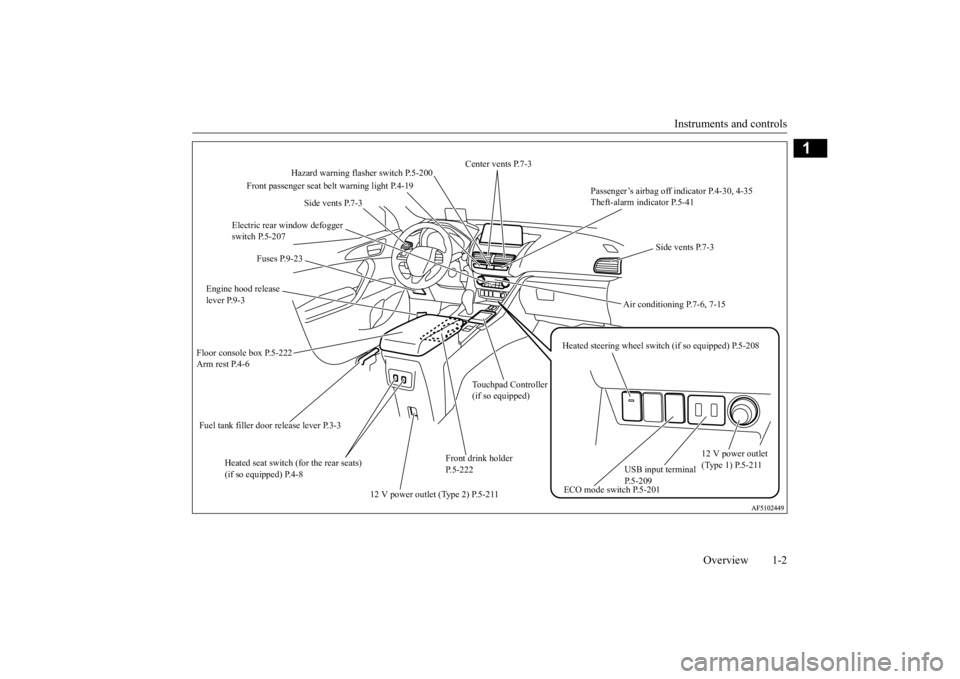
Instruments and controls
Overview 1-2
1
Hazard warning flasher switch P.5-200
Electric rear window defogger switch P.5-207
Fuel tank filler door release lever P.3-3 Engine hood release lever P.9-3 Floor console box P.5-222 Arm rest P.4-6
12 V power outlet (Type 1) P.5-211
Air conditioning P.7-6, 7-15
Passenger’s airbag off indicator P.4-30, 4-35 Theft-alarm indicator P.5-41
Front passenger seat belt warning light P.4-19
Heated steering wheel switc
h (if so equipped) P.5-208
Heated seat switch (for the rear seats) (if so equipped) P.4-8
Side vents P.7-3
ECO mode switch P.5-201
USB input terminal P.5-209
Center vents P.7-3
Fuses P.9-23
Front drink holder P.5-222
Side vents P.7-3
12 V power outlet (Type 2) P.5-211
Touchpad Controller (if so equipped)
BK0277700US.bo
ok 2 ページ 2019年3月8日 金曜日 午前9時23分
Page 23 of 427
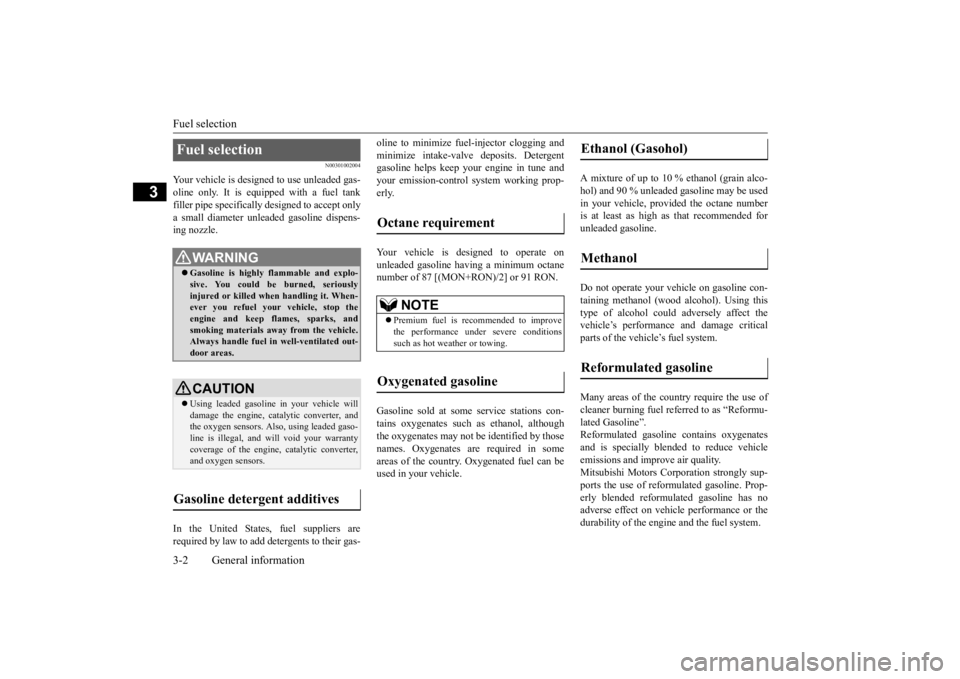
Fuel selection 3-2 General information
3
N00301002004
Your vehicle is designed to use unleaded gas- oline only. It is equipped with a fuel tankfiller pipe specifically designed to accept only a small diameter unleaded gasoline dispens- ing nozzle. In the United States, fuel suppliers are required by law to add detergents to their gas-
oline to minimize fuel-injector clogging and minimize intake-valve deposits. Detergent gasoline helps keep your engine in tune and your emission-control system working prop-erly. Your vehicle is designed to operate on unleaded gasoline having a minimum octanenumber of 87 [(MON+RON)/2] or 91 RON. Gasoline sold at some service stations con- tains oxygenates such as ethanol, although the oxygenates may not be identified by thosenames. Oxygenates are required in some areas of the country. Oxygenated fuel can be used in your vehicle.
A mixture of up to 10 % ethanol (grain alco- hol) and 90 % unleaded gasoline may be usedin your vehicle, provided the octane number is at least as high as that recommended for unleaded gasoline. Do not operate your vehicle on gasoline con- taining methanol (wood alcohol). Using this type of alcohol could adversely affect thevehicle’s performance and damage critical parts of the vehicle’s fuel system. Many areas of the country require the use of cleaner burning fuel referred to as “Reformu- lated Gasoline”.Reformulated gasoline contains oxygenates and is specially blended to reduce vehicle emissions and improve air quality.Mitsubishi Motors Cor
poration strongly sup-
ports the use of reformulated gasoline. Prop- erly blended reformulated gasoline has noadverse effect on vehicle performance or the durability of the engine and the fuel system.
Fuel selection
WA R N I N G Gasoline is highly flammable and explo- sive. You could be burned, seriouslyinjured or killed when handling it. When- ever you refuel your vehicle, stop the engine and keep flames, sparks, andsmoking materials away from the vehicle. Always handle fuel in well-ventilated out- door areas.CAUTION Using leaded gasoline in your vehicle will damage the engine, catalytic converter, and the oxygen sensors. Also, using leaded gaso-line is illegal, and will void your warranty coverage of the engine, catalytic converter, and oxygen sensors.
Gasoline detergent additives
Octane requirement
NOTE
Premium fuel is recommended to improve the performance under severe conditions such as hot w
eather or towing.
Oxygenated gasoline
Ethanol (Gasohol) Methanol Reformulated gasoline
BK0277700US.bo
ok 2 ページ 2019年3月8日 金曜日 午前9時23分
Page 24 of 427
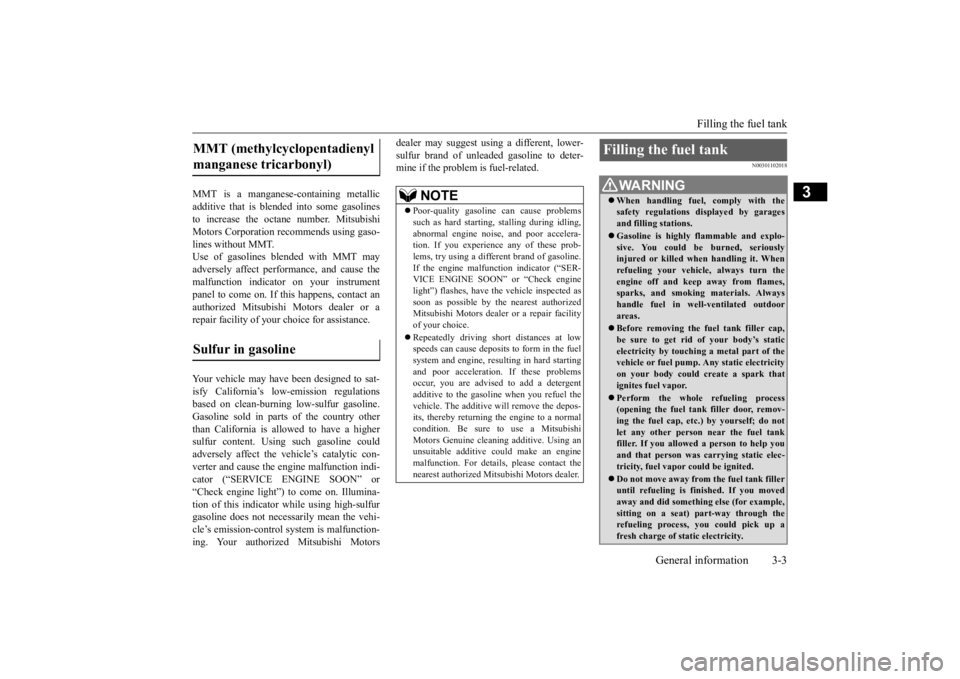
Filling the fuel tank
General information 3-3
3
MMT is a manganese-containing metallic additive that is blended into some gasolines to increase the octane number. Mitsubishi Motors Corporation recommends using gaso-lines without MMT. Use of gasolines blended with MMT may adversely affect performance, and cause themalfunction indicator on your instrumentpanel to come on. If this happens, contact an authorized Mitsubishi Motors dealer or a repair facility of your choice for assistance. Your vehicle may have been designed to sat- isfy California’s low-emission regulationsbased on clean-burning low-sulfur gasoline. Gasoline sold in parts of the country other than California is allowed to have a highersulfur content. Using such gasoline could adversely affect the vehicle’s catalytic con- verter and cause the engine malfunction indi-cator (“SERVICE ENGINE SOON” or “Check engine light”) to come on. Illumina- tion of this indicator while using high-sulfurgasoline does not necessarily mean the vehi- cle’s emission-control system is malfunction- ing. Your authorized Mitsubishi Motors
dealer may suggest using a different, lower- sulfur brand of unleaded gasoline to deter- mine if the problem is fuel-related.
N00301102018
MMT (methylcyclopentadienyl manganese tricarbonyl) Sulfur in gasoline
NOTE
Poor-quality gasoline can cause problems such as hard starting, stalling during idling, abnormal engine noise, and poor accelera- tion. If you experience any of these prob-lems, try using a different brand of gasoline. If the engine malfunction indicator (“SER- VICE ENGINE SOON” or “Check enginelight”) flashes, have the vehicle inspected as soon as possible by the nearest authorized Mitsubishi Motors dealer or a repair facilityof your choice. Repeatedly driving short distances at low speeds can cause deposits to form in the fuel system and engine, resulting in hard starting and poor acceleration. If these problemsoccur, you are advised to add a detergent additive to the gasoline when you refuel the vehicle. The additive will remove the depos-its, thereby returning the engine to a normal condition. Be sure to use a Mitsubishi Motors Genuine cleaning additive. Using anunsuitable additive could make an engine malfunction. For details, please contact the nearest authorized Mitsubishi Motors dealer.
Filling the fuel tank
WA R N I N G When handling fuel, comply with the safety regulations displayed by garages and filling stations. Gasoline is highly flammable and explo- sive. You could be burned, seriously injured or killed when handling it. Whenrefueling your vehicle, always turn the engine off and keep away from flames, sparks, and smoking materials. Alwayshandle fuel in well-ventilated outdoor areas. Before removing the fuel tank filler cap, be sure to get rid of your body’s static electricity by touching a metal part of thevehicle or fuel pump. Any static electricity on your body could create a spark that ignites fuel vapor. Perform the whole refueling process (opening the fuel tank filler door, remov-ing the fuel cap, etc.) by yourself; do not let any other person near the fuel tank filler. If you allowed a person to help youand that person was carrying static elec- tricity, fuel vapor could be ignited. Do not move away from the fuel tank filler until refueling is finished. If you movedaway and did something else (for example, sitting on a seat) part-way through the refueling process, you could pick up afresh charge of static electricity.
BK0277700US.bo
ok 3 ページ 2019年3月8日 金曜日 午前9時23分
Page 28 of 427
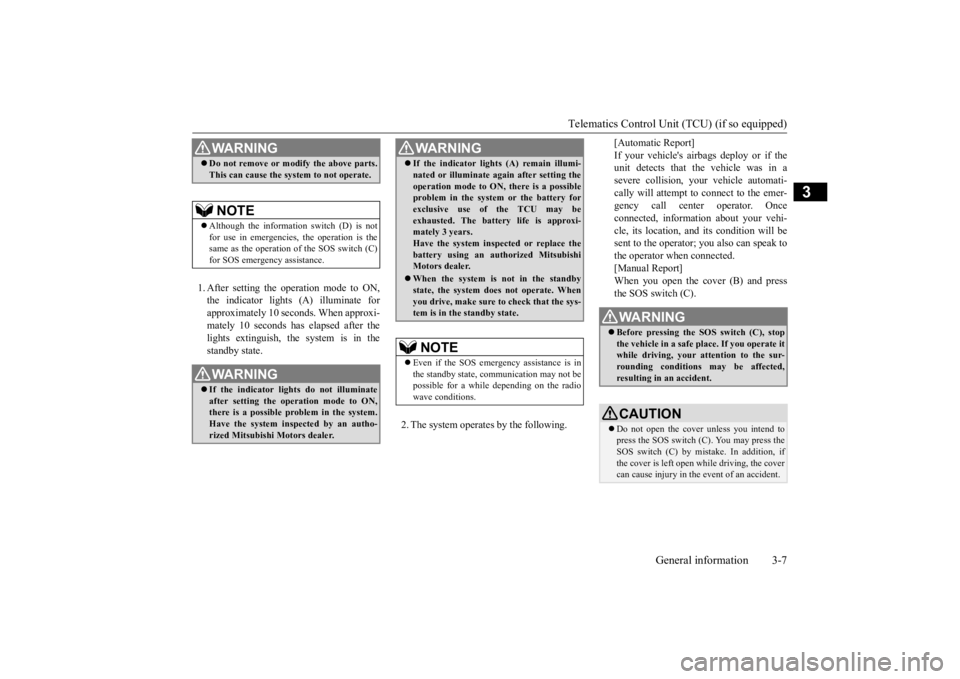
Telematics Control Unit (TCU) (if so equipped)
General information 3-7
3
1. After setting the operation mode to ON, the indicator lights (A) illuminate for approximately 10 seconds. When approxi-mately 10 seconds has elapsed after the lights extinguish, the system is in the standby state.
2. The system operates by the following.
[Automatic Report] If your vehicle's airbags deploy or if the unit detects that the vehicle was in a severe collision, your vehicle automati-cally will attempt to connect to the emer- gency call center operator. Once connected, information about your vehi-cle, its location, and its condition will be sent to the operator; you also can speak to the operator when connected.[Manual Report]When you open the cover (B) and press the SOS switch (C).
WA R N I N G Do not remove or modify the above parts. This can cause the system to not operate.NOTE
Although the information switch (D) is not for use in emergencies, the operation is the same as the operation of the SOS switch (C)for SOS emergency assistance.WA R N I N G If the indicator lights do not illuminate after setting the operation mode to ON,there is a possible problem in the system. Have the system inspected by an autho- rized Mitsubishi Motors dealer.
If the indicator lights (A) remain illumi- nated or illuminate again after setting the operation mode to ON, there is a possible problem in the system or the battery for exclusive use of the TCU may beexhausted. The battery life is approxi- mately 3 years. Have the system inspected or replace thebattery using an authorized Mitsubishi Motors dealer. When the system is not in the standby state, the system does not operate. When you drive, make sure to check that the sys-tem is in the standby state.NOTE
Even if the SOS emergency assistance is in the standby state, communication may not be possible for a while depending on the radiowave conditions.WA R N I N G
WA R N I N G Before pressing the SOS switch (C), stop the vehicle in a safe place. If you operate it while driving, your attention to the sur- rounding conditions may be affected,resulting in an accident.CAUTION Do not open the cover unless you intend to press the SOS switch (C). You may press the SOS switch (C) by mistake. In addition, if the cover is left open while driving, the covercan cause injury in the event of an accident.
BK0277700US.bo
ok 7 ページ 2019年3月8日 金曜日 午前9時23分
Page 32 of 427
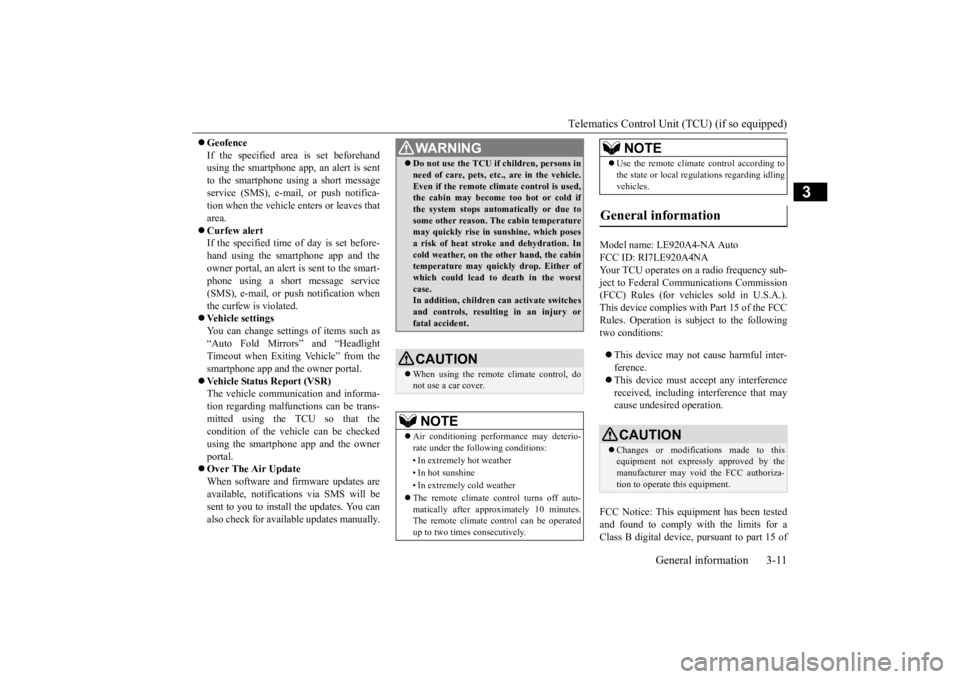
Telematics Control Unit (TCU) (if so equipped)
General information 3-11
3
Geofence If the specified area is set beforehand using the smartphone app, an alert is sent to the smartphone using a short messageservice (SMS), e-mail, or push notifica- tion when the vehicle enters or leaves that area. Curfew alert If the specified time of day is set before- hand using the smartphone app and theowner portal, an alert is sent to the smart-phone using a short message service (SMS), e-mail, or push notification when the curfew is violated. Vehicle settings You can change settings of items such as “Auto Fold Mirrors” and “HeadlightTimeout when Exiting Vehicle” from the smartphone app and the owner portal. Vehicle Status Report (VSR) The vehicle communication and informa- tion regarding malfunctions can be trans- mitted using the TCU so that thecondition of the vehicle can be checked using the smartphone app and the owner portal. Over The Air Update When software and firmware updates are available, notifications via SMS will besent to you to install the updates. You can also check for available updates manually.
Model name: LE920A4-NA Auto FCC ID: RI7LE920A4NAYour TCU operates on a radio frequency sub-ject to Federal Communications Commission (FCC) Rules (for vehicles sold in U.S.A.). This device complies with Part 15 of the FCCRules. Operation is subject to the following two conditions: This device may not cause harmful inter- ference. This device must accept any interference received, including interference that may cause undesired operation.
FCC Notice: This equipment has been tested and found to comply with the limits for a Class B digital device, pursuant to part 15 of
WA R N I N G Do not use the TCU if children, persons in need of care, pets, etc., are in the vehicle. Even if the remote climate control is used, the cabin may become too hot or cold if the system stops automatically or due tosome other reason. The cabin temperature may quickly rise in sunshine, which poses a risk of heat stroke and dehydration. Incold weather, on the other hand, the cabin temperature may quickly drop. Either of which could lead to death in the worstcase. In addition, children can activate switches and controls, resulting in an injury orfatal accident.CAUTION When using the remote climate control, do not use a car cover.NOTE
Air conditioning performance may deterio- rate under the following conditions: • In extremely hot weather • In hot sunshine • In extremely cold weather The remote climate control turns off auto- matically after approximately 10 minutes.The remote climate control can be operated up to two times consecutively.
Use the remote climate control according to the state or local regulations regarding idling vehicles.
General information
CAUTION Changes or modifications made to this equipment not expressly approved by themanufacturer may void the FCC authoriza- tion to operate this equipment.NOTE
BK0277700US.bo
ok 11 ページ 2019年3月8日 金曜日 午前9時23分
Page 35 of 427
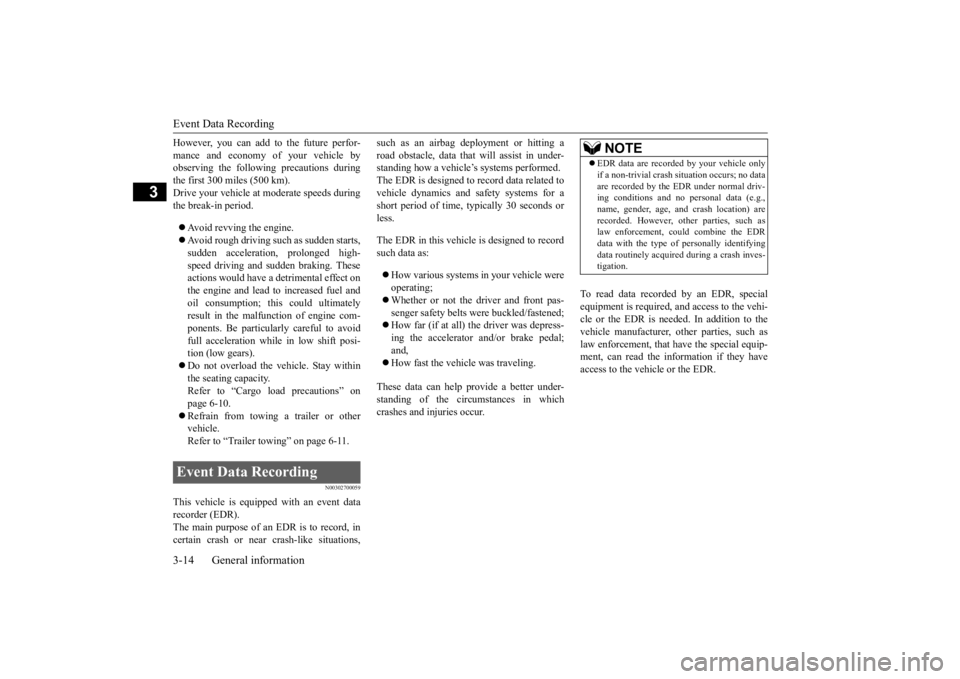
Event Data Recording 3-14 General information
3
However, you can add to the future perfor- mance and economy of your vehicle by observing the follow
ing precautions during
the first 300 miles (500 km).Drive your vehicle at moderate speeds during the break-in period. Avoid revving the engine. Avoid rough driving such as sudden starts, sudden acceleration, prolonged high- speed driving and sudden braking. These actions would have a detrimental effect onthe engine and lead to increased fuel andoil consumption; this could ultimately result in the malfunction of engine com- ponents. Be particularly careful to avoidfull acceleration while in low shift posi- tion (low gears). Do not overload the vehicle. Stay within the seating capacity. Refer to “Cargo load precautions” on page 6-10. Refrain from towing a trailer or other vehicle. Refer to “Trailer towing” on page 6-11.
N00302700059
This vehicle is equipped with an event datarecorder (EDR).The main purpose of an EDR is to record, in certain crash or near crash-like situations,
such as an airbag deployment or hitting a road obstacle, data that will assist in under- standing how a vehicle’s systems performed. The EDR is designed to record data related tovehicle dynamics and safety systems for a short period of time, typically 30 seconds or less. The EDR in this vehicle is designed to record such data as: How various systems in your vehicle were operating; Whether or not the driver and front pas- senger safety belts were buckled/fastened; How far (if at all) the driver was depress- ing the accelerator and/or brake pedal; and, How fast the vehicle was traveling.
These data can help provide a better under- standing of the circumstances in which crashes and injuries occur.
To read data recorded by an EDR, special equipment is required, and access to the vehi- cle or the EDR is needed. In addition to the vehicle manufacturer, other parties, such aslaw enforcement, that have the special equip- ment, can read the information if they have access to the vehicle or the EDR.
Event Data Recording
NOTE
EDR data are recorded by your vehicle only if a non-trivial crash situation occurs; no data are recorded by the EDR under normal driv- ing conditions and no personal data (e.g., name, gender, age, and crash location) arerecorded. However, other parties, such as law enforcement, could combine the EDR data with the type of personally identifyingdata routinely acquired during a crash inves- tigation.
BK0277700US.bo
ok 14 ページ 2019年3月8日 金曜日 午前9時23分
Page 56 of 427
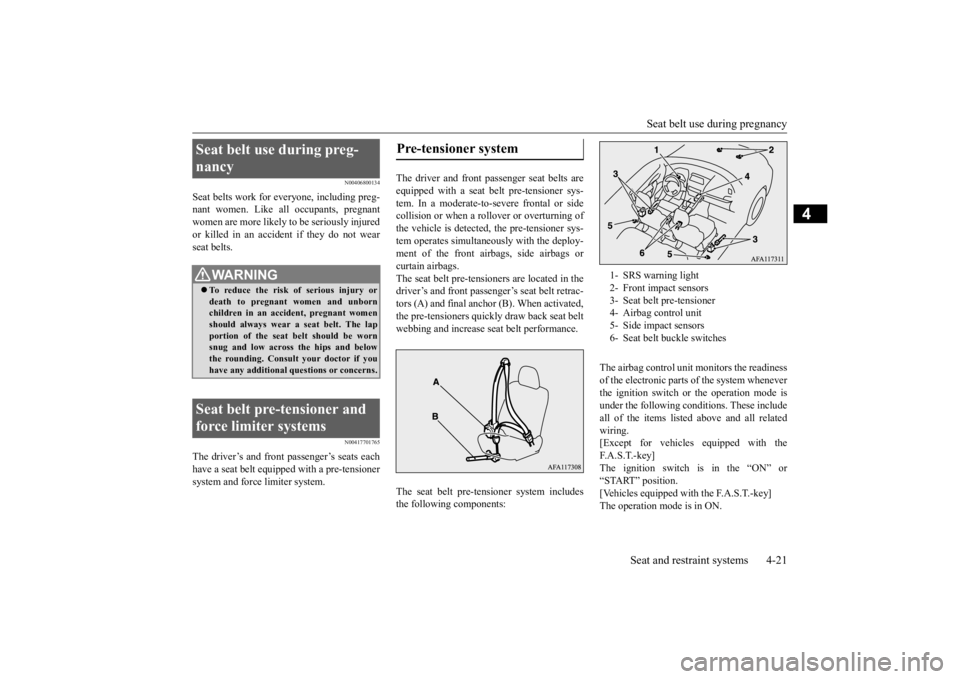
Seat belt use during pregnancy
Seat and restraint systems 4-21
4
N00406800134
Seat belts work for ev
eryone, including preg-
nant women. Like all occupants, pregnantwomen are more likely to be seriously injured or killed in an accident if they do not wear seat belts.
N00417701765
The driver’s and front passenger’s seats eachhave a seat belt equipped with a pre-tensioner system and force limiter system.
The driver and front passenger seat belts are equipped with a seat belt pre-tensioner sys-tem. In a moderate-to-severe frontal or side collision or when a rollover or overturning of the vehicle is detected, the pre-tensioner sys-tem operates simultaneously with the deploy- ment of the front airbags, side airbags or curtain airbags.The seat belt pre-tensioners are located in thedriver’s and front passenger’s seat belt retrac- tors (A) and final anchor (B). When activated, the pre-tensioners quickly draw back seat beltwebbing and increase seat belt performance. The seat belt pre-tensioner system includes the following components:
The airbag control unit monitors the readiness of the electronic parts of the system wheneverthe ignition switch or the operation mode is under the following conditions. These include all of the items listed above and all relatedwiring. [Except for vehicles equipped with the F. A . S . T. - k e y ]The ignition switch is in the “ON” or “START” position. [Vehicles equipped with the F.A.S.T.-key]The operation mode is in ON.
Seat belt use during preg- nancy
WA R N I N G To reduce the risk of serious injury or death to pregnant women and unbornchildren in an accident, pregnant women should always wear a seat belt. The lap portion of the seat belt should be wornsnug and low across the hips and below the rounding. Consult your doctor if you have any additional questions or concerns.
Seat belt pre-tensioner and force limiter systems
Pre-tensioner system
1- SRS warning light 2- Front impact sensors 3- Seat belt pre-tensioner 4- Airbag control unit5- Side impact sensors 6- Seat belt buckle switches
BK0277700US.bo
ok 21 ページ 2019年3月8日 金曜日 午前9時23分
Page 57 of 427
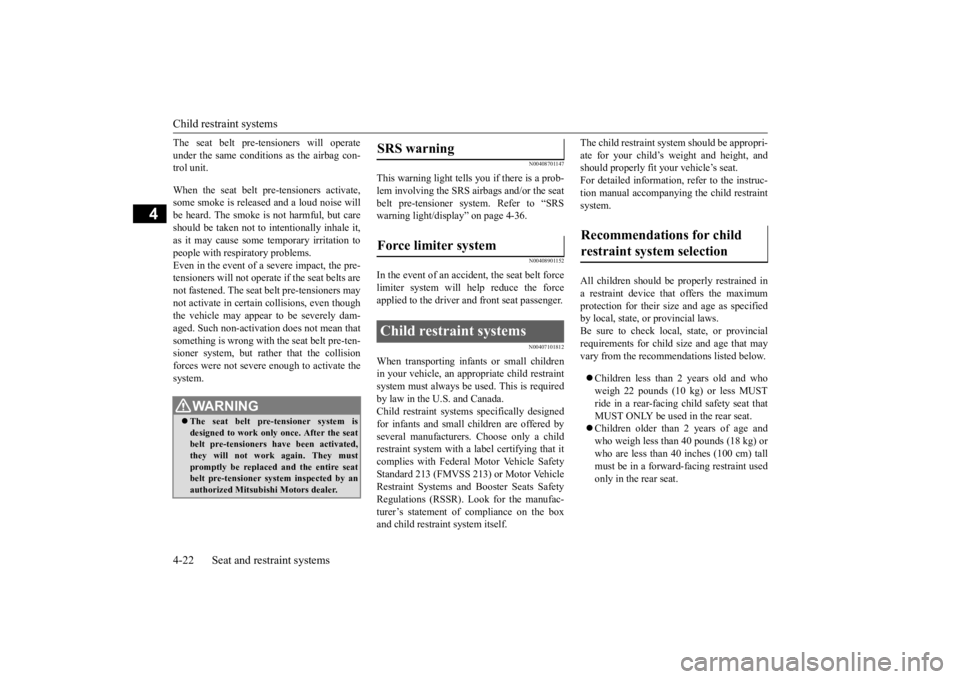
Child restraint systems 4-22 Seat and restraint systems
4
The seat belt pre-tensioners will operate under the same conditions as the airbag con- trol unit. When the seat belt pre-tensioners activate, some smoke is released and a loud noise willbe heard. The smoke is not harmful, but care should be taken not to intentionally inhale it, as it may cause some temporary irritation topeople with respiratory problems. Even in the event of a severe impact, the pre- tensioners will not operate if the seat belts arenot fastened. The seat belt pre-tensioners maynot activate in certain
collisions, even though
the vehicle may appear to be severely dam- aged. Such non-activation does not mean thatsomething is wrong with the seat belt pre-ten- sioner system, but rather that the collision forces were not severe enough to activate thesystem.
N00408701147
This warning light tells you if there is a prob-lem involving the SRS airbags and/or the seatbelt pre-tensioner system. Refer to “SRS warning light/display” on page 4-36.
N00408901152
In the event of an accident, the seat belt force limiter system will help reduce the force applied to the driver and front seat passenger.
N00407101812
When transporting infants or small childrenin your vehicle, an appropriate child restraint system must always be used. This is requiredby law in the U.S. and Canada. Child restraint systems specifically designed for infants and small children are offered byseveral manufacturers. Choose only a child restraint system with a label certifying that it complies with Federal Motor Vehicle SafetyStandard 213 (FMVSS 213) or Motor Vehicle Restraint Systems and Booster Seats Safety Regulations (RSSR). Look for the manufac-turer’s statement of compliance on the box and child restraint system itself.
The child restraint system should be appropri- ate for your child’s weight and height, and should properly fit your vehicle’s seat. For detailed information, refer to the instruc-tion manual accompanying the child restraint system. All children should be properly restrained in a restraint device that offers the maximum protection for their size and age as specifiedby local, state, or provincial laws. Be sure to check local, state, or provincial requirements for child size and age that mayvary from the recommendations listed below. Children less than 2 years old and who weigh 22 pounds (10 kg) or less MUST ride in a rear-facing child safety seat thatMUST ONLY be used in the rear seat. Children older than 2 years of age and who weigh less than 40 pounds (18 kg) orwho are less than 40 inches (100 cm) tall must be in a forward-facing restraint used only in the rear seat.
WA R N I N G The seat belt pre-tensioner system is designed to work only once. After the seat belt pre-tensioners have been activated, they will not work again. They must promptly be replaced and the entire seat belt pre-tensioner system inspected by anauthorized Mitsubishi Motors dealer.
SRS warning Force limiter system Child restraint systems
Recommendations for child restraint system selection
BK0277700US.bo
ok 22 ページ 2019年3月8日 金曜日 午前9時23分
Page 68 of 427
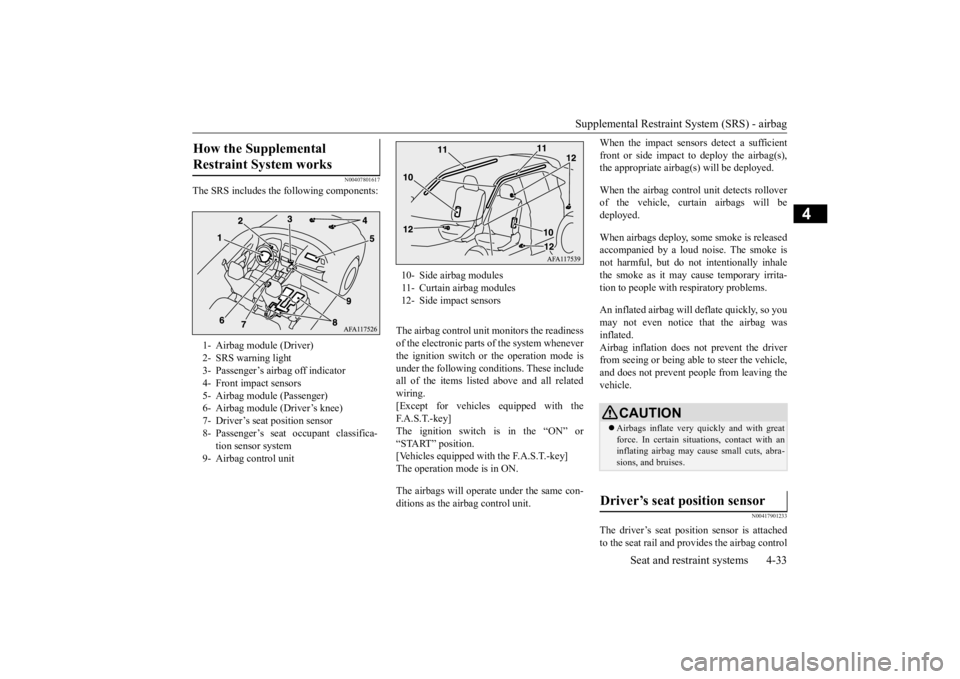
Supplemental Restraint System (SRS) - airbag
Seat and restraint systems 4-33
4
N00407801617
The SRS includes the following components:
The airbag control unit monitors the readiness of the electronic parts of the system whenever the ignition switch or the operation mode isunder the following conditions. These includeall of the items listed above and all related wiring. [Except for vehicles equipped with theF. A . S . T. - k e y ] The ignition switch is in the “ON” or “START” position.[Vehicles equipped with the F.A.S.T.-key] The operation mode is in ON. The airbags will operate under the same con- ditions as the airbag control unit.
When the impact sensors detect a sufficient front or side impact to deploy the airbag(s), the appropriate airbag(s) will be deployed. When the airbag control unit detects rollover of the vehicle, curtain airbags will bedeployed. When airbags deploy, some smoke is released accompanied by a loud noise. The smoke is not harmful, but do not intentionally inhalethe smoke as it may cause temporary irrita-tion to people with respiratory problems. An inflated airbag will deflate quickly, so you may not even notice that the airbag was inflated.Airbag inflation does not prevent the driver from seeing or being able to steer the vehicle, and does not prevent people from leaving thevehicle.
N00417901233
The driver’s seat position sensor is attachedto the seat rail and provides the airbag control
How the Supplemental Restraint System works 1- Airbag module (Driver) 2- SRS warning light 3- Passenger’s airbag off indicator 4- Front impact sensors5- Airbag module (Passenger)6- Airbag module (Driver’s knee) 7- Driver’s seat position sensor 8- Passenger’s seat occupant classifica-
tion sensor system
9- Airbag control unit
10- Side airbag modules 11- Curtain airbag modules 12- Side impact sensors
CAUTION Airbags inflate very quickly and with great force. In certain situations, contact with an inflating airbag may cause small cuts, abra- sions, and bruises.
Driver’s seat position sensor
BK0277700US.bo
ok 33 ページ 2019年3月8日 金曜日 午前9時23分
Page 69 of 427
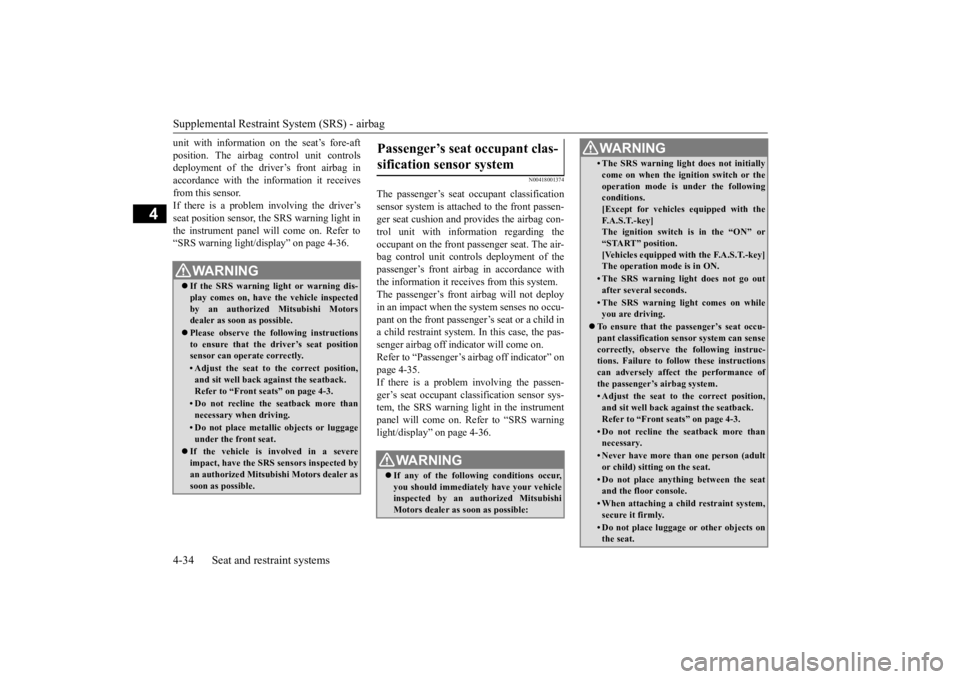
Supplemental Restraint System (SRS) - airbag 4-34 Seat and restraint systems
4
unit with information on the seat’s fore-aft position. The airbag control unit controls deployment of the driver’s front airbag in accordance with the information it receivesfrom this sensor. If there is a problem involving the driver’s seat position sensor, the SRS warning light inthe instrument panel will come on. Refer to “SRS warning light/display” on page 4-36.
N00418001374
The passenger’s seat occupant classification sensor system is attached to the front passen- ger seat cushion and provides the airbag con- trol unit with information regarding theoccupant on the front passenger seat. The air- bag control unit controls deployment of the passenger’s front airbag in accordance withthe information it receives from this system.The passenger’s front airbag will not deploy in an impact when the system senses no occu- pant on the front passenger’s seat or a child ina child restraint system. In this case, the pas- senger airbag off indicator will come on. Refer to “Passenger’s airbag off indicator” onpage 4-35. If there is a problem involving the passen- ger’s seat occupant classification sensor sys-tem, the SRS warning light in the instrument panel will come on. Refer to “SRS warning light/display” on page 4-36.
WA R N I N G If the SRS warning light or warning dis- play comes on, have the vehicle inspected by an authorized Mitsubishi Motors dealer as soon as possible. Please observe the following instructions to ensure that the driver’s seat positionsensor can operate correctly.• Adjust the seat to the correct position,and sit well back against the seatback. Refer to “Front seats” on page 4-3.• Do not recline the seatback more thannecessary when driving.• Do not place metallic objects or luggageunder the front seat.
If the vehicle is involved in a severe impact, have the SRS sensors inspected by an authorized Mitsubishi Motors dealer as soon as possible.
Passenger’s seat occupant clas- sification sensor system
WA R N I N G If any of the following conditions occur, you should immediately have your vehicleinspected by an authorized Mitsubishi Motors dealer as soon as possible:
• The SRS warning light does not initiallycome on when the ignition switch or the operation mode is under the following conditions. [Except for vehicles equipped with theF. A . S . T. - k e y ] The ignition switch is in the “ON” or “START” position.[Vehicles equipped with the F.A.S.T.-key] The operation mode is in ON.• The SRS warning light does not go outafter several seconds.• The SRS warning light comes on whileyou are driving.
To ensure that the passenger’s seat occu- pant classification sensor system can sense correctly, observe the following instruc-tions. Failure to follow these instructions can adversely affect the performance of the passenger’s airbag system.• Adjust the seat to the correct position,and sit well back against the seatback.Refer to “Front seats” on page 4-3.• Do not recline the seatback more thannecessary.• Never have more than one person (adultor child) sitting on the seat.• Do not place anything between the seat and the floor console.• When attaching a child restraint system,secure it firmly.• Do not place luggage or other objects onthe seat.WA R N I N G
BK0277700US.bo
ok 34 ページ 2019年3月8日 金曜日 午前9時23分